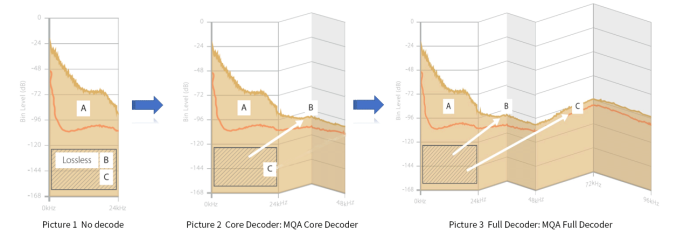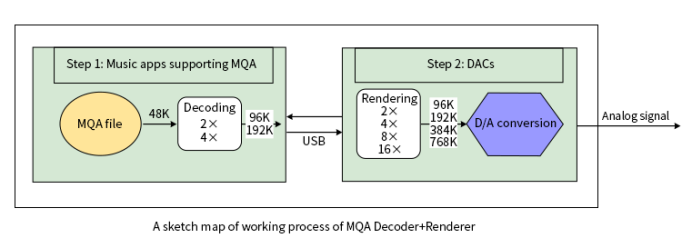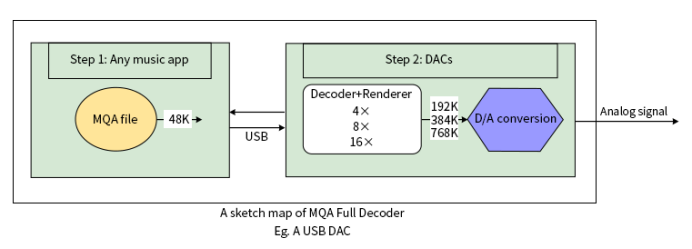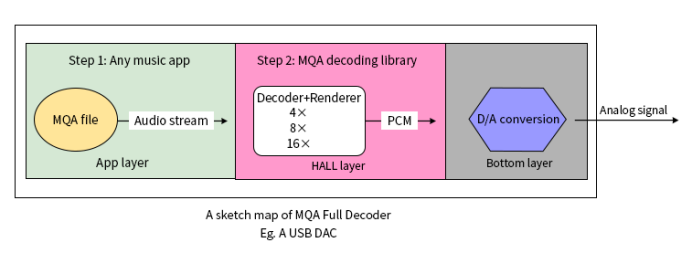--From @FiiO Willson
1. A brief introduction to MQA
There are already many introductory articles on the Internet, so here I would like to give a brief explanation.
1) The working principle of MQA is to fold the high sampling rate master
recording just like folding paper over and over again, to shrink the
original file for convenient transmission. The lossy compressed MQA file
is FLAC encapsulated with a sampling rate of 44.1k or 48k, 88.2k and
96k.

2. To unfold the MQA file layer by layer and reveal the original master resolution, is called MQA decoding.

The above sketch map comes from MQA's official website. Figure 2 refers to the frequency range instead of the sampling rate.
2. Three different types of MQA decoding approaches
Many manufacturers mention their products support MQA, yet without
saying which type of MQA it is, which makes ordinary consumers confused.
Here, I would like to introduce 3 commonly-used MQA concepts and
corresponding characteristics.
1) MQA Decoder
· Purpose: The first step of MQA decoding, think of it as opening an
origami paper, is to figure out the folding lines and unlock the first
layer.
· Implementation method: This step is usually implemented by music apps, such as TIDAL, ROON (FiiO Music app will soon be one of them).
· Outcome: 2x unfolding after decoding, the output sampling rate is 88.2k or 96k.
2) MQA Renderer
· Purpose: With an appropriate music app supporting MQA, unfold the decoded audio stream again.
· Implementation method: Complete decoding through the XMOS chip or a DAC chip that supports MQA Renderer.
· Outcome: Going through Rendering and a second unfolding, the complete
MQA decoding process will be completed. The highest unfolding level
depends on the maximum performance of the system or DAC chip. MQA 8x
achieves a sampling rate up to 384k, and MQA 16x up to 768k. The MQA
authority told us that there will even be MQA 32x supported in the
future.
Take USB audio adapters as an example. Here is a flow diagram showing the whole MQA process from Decoder to Renderer

3) MQA Full Decoder
This kind is to integrate steps 1 and 2, 1 plus 2 is 3.
· Purpose: In a system with strong enough processing power, the whole decoding process can be completed at one time.
· Implementation method: Complete decoding through the SoC, audio DSP or XMOS.
· Outcome: After the Full Decoder process, the whole file will be decoded entirely without any additional device.
Take the common desktop DAC and audio player as an example to show the whole process of MQA Full Decoder


According to the above introduction, let's make a brief comparison of the three different decoding methods in a table.
MQA decoding methods and their respective characteristics
MQA decoding | Product category (example) | Implementation premise | Implementation method | Implementation characteristics |
Decoder | Music app | MQA authorized and is equipped with a thorough billing account management system | Core library | Easy to access |
Renderer | USB decoding device | Must work with a music app that supports MQA | XMOS library or a DAC chip with built-in MQA Renderer | Lower cost |
Full Decoder | Audio player, USB decoding device | Strong enough audio processing capacity | MQA complete library+DSP | Full and efficient |
3. MQA opens different authorization methods for different product types
Since there are many types of audio devices on the market and a variety
of suitable listening scenarios, MQA provides different authorization
methods according to different characteristics and usage scenarios of
these devices.
1) Music apps (MQA Core Decoder)
MQA licenses some music apps separately for mobile and desktop devices,
such as Tidal for mobile phones, and Audirvana for PCs. These music apps
support streaming and MQA decoding, so users can enjoy MQA tracks with portable DACs.
However, the authorization of MQA decoding involves authorization fee,
so those music apps that support MQA are required to include a
chargeable account system to obtain the official MQA certification.
The FiiO Music app is also planning to add the MQA Decoder support.
Because the independent account system with the global charging function
involves many security issues, it took a lot of time for us to deal
with it. But now the development is near completion, and MQA officials
are testing and verifying.
2) Audio player (MQA Full Decoder)
Audio players have developed with a nearly perfect architecture to this
day, basically with the complete function of "online/local playback +
decoding + amplification", such as FiiO's M11 series, the M15 and M17.
MQA officials believe that such devices are fully qualified to provide a
one-stop solution, so it authorizes them MQA Full Decoder. But the USB
DAC function of audio players will be authorized separately, which might
be the MQA Full Decoder or MQA Renderer.
3) Portable DAC (MQA Renderer and Full Decoder)
Such devices are generally "USB audio adapters (small USB DAC and
Amplifier)" or "portable DAC/Amps with a built-in battery, which are
used with mobile phones or PCs.
With the help of the authorized MQA support for music apps on mobile
phones and PCs, such devices only need to support MQA Renderer.
Connecting them can achieve MQA Full Decoder. For sure, portable DACs
are also authorized to support MQA Full Decoder.
3.1) It can be realized through the USB XMOS. For example, the XMOS 208
supports MQA Renderer, and the XMOS 216 supports MQA Full Decoder.
3.2) It can also be realized through the DAC that supports MQA Renderer.
4) Desktop DAC
This type of device generally represents the high-end performance of
DAC, and they usually work with various music apps (not necessarily a
music app that supports MQA). Therefore, it has relatively higher
requirements for openness, as well as implementation methods. In theory,
MQA only authorizes MQA Full Decoder, so it is suggested to use the
XMOS216 chip or chips with higher performance. But there are exceptions,
such as
4.1) The one equipped with a DAC chip with its own MQA Renderer, like the ES9068AS. It can also be authorized MQA Renderer.
4.2) The K9 Pro has a Type-C port that is easy to connect to mobile
phones for decoding. Also, it supports MQA Renderer (but later MQA told
us that it is not recommended to use the XMOS208 chip to implement MQA
Renderer, while the FiiO K9 Pro is the only exception. In the future,
other models, except for the K9 Pro series, will not be authorized
anymore).
4. FiiO existing products that support MQA
FiiO has already implemented MQA since the M11 Pro in 2019, and now has
realized MQA Full Decoder in all Android players. DAC and headphone
amplifiers have relatively slow progress in MQA introduction. It started
from the K9 Pro that supports MQA Renderer.
*Note: Although many headphone amplifiers use the XMOS chip, there will
be differences in different products due to the official MQA
authorization conditions and the limited processing capability of the
XMOS208. There is no guarantee that products using the XMOS208 chip can
stably support MQA because there will be conflicts of MQA decoding
resources in the actual application of different projects.
Product type | Model | Decoding type | Multiple of decoding |
Audio player | M11 | Full Decoder | 8× |
| M11 Pro | Full Decoder | 8× |
| M15 | Full Decoder | 8× |
| M11 Plus LTD | Full Decoder | 8× |
| M17 | Full Decoder | 8× |
| M11 Plus | Full Decoder | 8× |
DAC /Amp | K9 Pro | Renderer | 8× |
| BTR5 2021 | Renderer | 8× |
| K9 Pro ESS | Renderer | 8× |
5. FiiO future products that support MQA
1) FiiO's future smart music players will continue to support MQA Full Decoder.
2) FiiO's future DACs will use the new XMOS316, which aims to support MQA Full Decoder.
*Notes:
1) Because the production process of XMOS208/216 is the same as that of
automotive semiconductors, and the current supply situation is still
tough, we decided to use the XMOS316 with a new process, which will help
the continuous sales of our products.
2) At present, for the new XMOS316 chip, we have already discussed its
code realizability. And it is expected to be applied to our new products
soon.
6. Can FiiO's old products support MQA through an upgrade?
1) Some of FiiO's old products had not established connections with MQA
before entering the market, such as the Q1MKII, Q3, Q5s. So, they cannot
support MQA.
2) For the recently released products, such as the M17, whose audio
processing is handled by both the SoC and XMOS chips, even though they
use the XMOS chip for USB decoding, the two audio processing cores will
conflict when receiving MQA data stream, which is probably because the
processing capacity of the XMOS208 has reached the maximum. Our
engineers have been discussing solutions with MQA officials. Therefore,
MQA Renderer will still be unavailable under USB DAC mode until we work
out a perfect solution.
As mentioned above, individual products may not be able to introduce MQA
due to the actual resource load of the XMOS208. But we will keep
examining one by one, upgrading the code of the product that is capable
of supporting MQA, and reporting it to the MQA official. It will be
available through upgrade once it passes the test. Please pay attention
to the official announcement for the specific progress.
 After sales policy
After sales policy
 Legal Notice
Legal Notice
 Privacy Policy
Privacy Policy
 Intellectual Property Rights Statement
Intellectual Property Rights Statement

 简体中文
简体中文